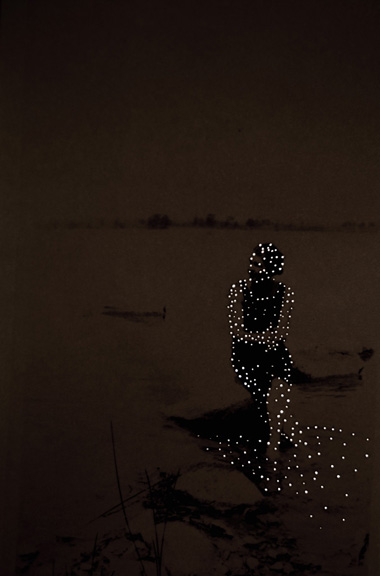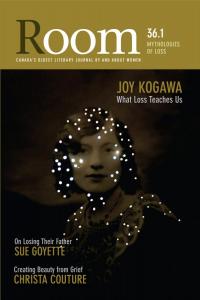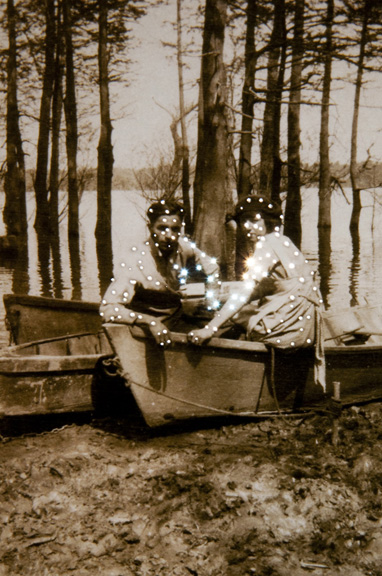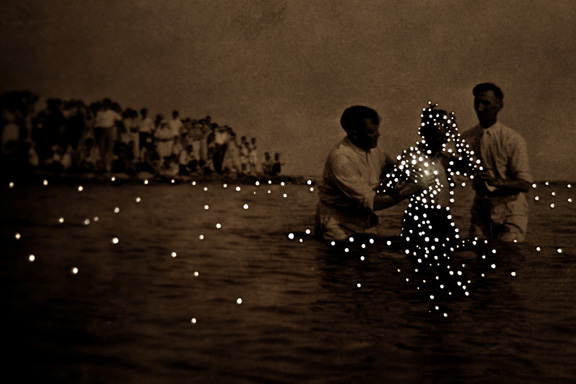In this interview, Lindsay Glauser Kwan talked to artist Amy Friend about photography, light and the cover of past issue 36.1 Mythologies of Loss.
In this interview, Lindsay Glauser Kwan talked to artist Amy Friend about photography, light and the cover of past issue 36.1 Mythologies of Loss.
ROOM: What inspires your work?
AF: The Dare alla Luce series began like much of my work. I start in a specific direction, but I prefer to experiment and play with the possibilities of my ideas in order to let them form in a natural manner. In my previous work, the “family album” was a strong focal point and this continual interest led to my exploration of what I like to call, the “lost images.” Photographs without a home.
My own albums (some quite old and given to me by my Nonna) hold images that are lost, despite being housed in the albums. Nobody is able to identify the people in the photographs. I aimed to make these pictures precious again, to somehow validate that loss. Initially, I began by embroidering on the photographs to transform them into a “new object.” While sewing, I would hold the photograph to the light in order to determine the placement of the pinholes. I recognized that the pinholes and subsequent light shining through were far more interesting to me and decided to work toward exploring that avenue of my process.

Late Summer Evening, Ontario, 1927
2012; archival pigment print
The direction I take with my work often flows this way; I start “somewhere” and allow it to happen, rather than control every aspect along the way. Much of my practice is inspired or triggered by my surroundings and life circumstances. While that is a rather broad explanation of where my interests lie, I tend to focus on a detail or story and let the wind work its way into my process.
 ROOM: Your artwork was featured in our 36.1 Mythologies of Loss issue. How did your artwork represent the theme to you?
ROOM: Your artwork was featured in our 36.1 Mythologies of Loss issue. How did your artwork represent the theme to you?
AF: I think this work operates on a few levels. First, it brings together a selection of photographs from disparate places. The people in the photographs come together; strangers are united. The people in the photographs have their individual and personal history; I find that both compelling and quite sad. What does this loss of provenance mean? I am not sure what the answer is to that question, yet. And finally, we will all fade in history, life constantly shifts, as do memories and our relationship to what remains. On another note, the photos take on their own life they become a part of the “mythology” of photography.
ROOM: Do you work primarily with photography?
AF: At this time I am working mostly with the medium of photography. I engage with the specificity of the medium; it instigates the way I approach my ideas. I eventually plan to introduce other media and methodologies to my artistic “repertoire”; installation is of particular interest. Additionally, I use hands-on production techniques with my photographs. Some photos are directly painted on while others are manipulated using a plethora of techniques, analog and digital and experimental.

We are a Tablet of Wax
2012; archival pigment print
ROOM: Light is both essential to the original photographic process but also in your manipulations, hence the title of the series “Dara all Luce.” In Italian this means “to bring to the light.” What is the significance of light to you in this series?
AF: Photography cannot exist without light. In traditional photographic production it enables the creation of the image through chemical reactions that occur between light and silver halides on film. In terms of both its optical properties and metaphoric potential, light suggests a broad spectrum of possible meanings; it becomes one of the unifying elements in the work, generating an aesthetic and poetic interrelationship. It can be thought of as revelatory, transformative, secretive, even elusive. The quality of light, reproduced in the photographs, alludes to time and passage, to rhythms, to continuance. Even with the light that no longer emanates from its original source but by a surrogate source, in this case the photograph, we continue to be affected in some way by the original source despite its displacement. While I am discussing light here as a referent, this could easily extend to address ideas that Susan Sontag reveals with regard to the referent as a being and how it affects us:
The photograph is literally an emanation of the referent. From a real body, which was there, proceed radiations which ultimately touch me, who am here; the duration of the transmission is insignificant; the photograph of the missing being, as Sontag says, will touch me like the delayed rays of a star. A sort of umbilical cord links the body of the photographed thing to my gaze: light, though impalpable, is here a carnal medium, a skin I share with anyone who has been photographed. (Barthes 80)
If we extend these thoughts further, are photographs capable of moving from the referent-as-body to the referent as a possible point of access to the invisible? If the referent becomes immaterial, is it the “immaterial” that glows and is present?

What is done in the darkness, will be brought to the light
2012; archival pigment print
ROOM: Can you tell us a little about your process? How do you choose the vintage images and how do you determine where to add the light?
AF: Initially I choose images that I found compelling. They had that unspeakable, “something” that drew me to them or there was a notation on the photograph that I felt was important for the direction of the work. Many of the photos I found were familiar and some were so strange. We are all unique and somehow we share many of the same circumstances in life. As I continued my search, I discovered that there is a huge market for specific themes in vernacular photography. I became interested in this and purchased a few photographs based on my observations of that demand as well.

Lake Rousseau, 1931
2012; archival pigment print
ROOM: Are you still working on this series? What else are you currently working on?
AF: I have said to myself that I am finished with the series, but that is a lie. I think I am a little addicted to the found images. And, there is something more I need to explore about this work. Clearly, I do not know what that is yet.
I have a few projects in the works. One deals with a collection of old letters that my Nonna saved for over 50 years from her relatives in Italy. There are over 250 letters; they are worn and delicate, the paper is tissue-like and the script is stunning. Some were mailed during WW2 and are censored. I am also working on a project about the sale of vernacular photographs online. I am sure you can guess how that idea was spurred.

Ruth, October, 1936
2012; archival pigment print

ROOM: Where can readers of Room see more of your work?
AF: My work was recently published on the cover of Le mur mitoyen by Catherine Leroux. I have not read it yet, (sadly I cannot read advanced French). But she just won the Prix France-Québec. I believe it will be translated at some point.
There is more work coming up on my site soon and there is a selection of pieces not on my site at Citizen Atlier.
I have a few upcoming exhibitions in December at 555 Gallery in Boston and if you are in my region (Niagara, Ontario) I have new work that will is slated to exhibit in January of 2016 at Rodman Hall Art Center in St. Catharines.
Amy Friend currently resides in St. Catherines, Ontario where she teaches at Brock University. Her work often explores notions of memory, freedom, infinity, and the invisible. She has exhibited nationally and internationally, and is represented by Art Interiors and Galierie Riviere/Faiveley in Paris.
Do you want to see your work featured on the cover of Room? See our submission guidelines and send us your best work.














